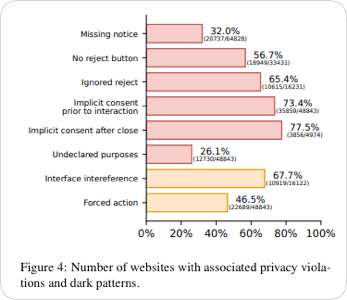In news that is, sadly, unlikely to shock you, new research indicates that many websites ignore visitors’ choices to refuse cookies and collect their data anyway.
Researchers at the University of Amsterdam (UvA) analyzed 85,000 European websites and came to the conclusion that 90% of them violated at least one privacy regulation.

Cookies are bits of data that websites save on your computer when you look at a page, view an image, download a file, or interact with them in any other way. Cookies help websites remember you, which is often useful, particularly if you are logging in to a website, but they can also be used for things that some users don’t like, such as tracking. Tracking cookies are used by marketers to target you with ads that may interest you based on your browsing habits.
Working with researchers from Swiss university ETH Zürich, the team from UvA created a machine-learning tool that allowed them to analyze 100,000 websites. The main goal was to compare what information websites said they would gather with what they actually did. The researchers found an enormous number of privacy violations.
To make the data a bit more insightful, they discriminated between “naive” violations and deliberate violations.
Naive violations are things like not offering a choice to reject cookies (affecting 57% of sites), and forgetting to ask for permission to store cookies (which occurred on 32% of websites visited by Europeans). Forgetting to ask for permission, or making it very hard to reject cookies, is very easy to spot, yet several major website owners have already been fined for violations like this.
But then we enter the realm of deliberate privacy violations. Of the websites that offered visitors a choice, 65% used tracking cookies, even if visitors chose to reject them. In many cases, websites created the cookies even before the visitor had the chance to make their choice.
More than 77% of the websites chose to interpret closing a cookie notification dialog as user consent.
On top of this, many websites also used so-called “dark patterns” to manipulate visitors into making the site’s preferred choice. Dark patterns, also known as deceptive design patterns, occur when a user interface has been crafted to nudge or trick users into doing things they didn’t set out to do.
Dark patterns are not subliminal messaging or visual or auditory stimuli that the conscious mind cannot perceive, although advertisers have been accused of using those as well. It’s more like making the accept button bright and easy to find and the reject button dark, smaller, or harder to read.
The researchers came to the conclusion that the way the cookie consent system is working is far from satisfactory. Small websites don’t have the technical and legal knowledge to comply, and some others are simply choosing to ignore or bend the rules.
And warnings to website owners seem to fall on deaf ears. Since March 31, 2021, when the deadline set for websites and mobile applications to comply with the new rules on cookies expired, the French privacy watchdog Commission Nationale de l’Informatique et des Libertés (CNIL) has adopted nearly 100 corrective measures (orders and sanctions) related to non-compliance with the legislation on cookies.
We don’t just report on privacy—we offer you the option to use it.
Privacy risks should never spread beyond a headline. Keep your online privacy yours by using Malwarebytes Privacy VPN.










